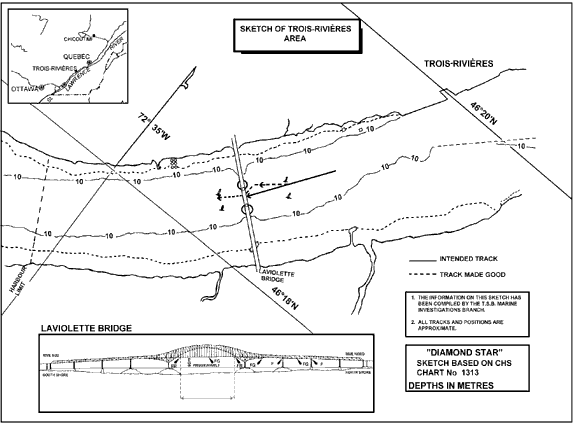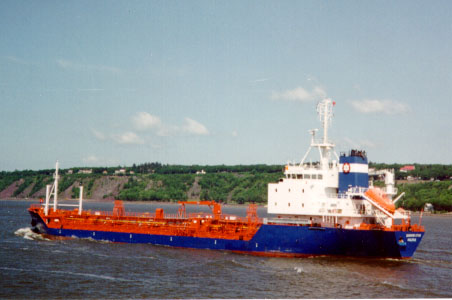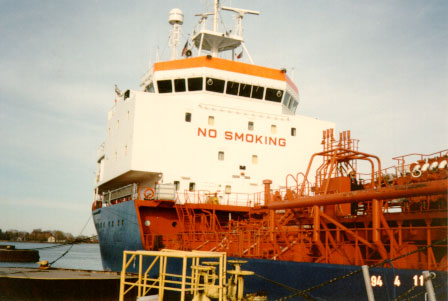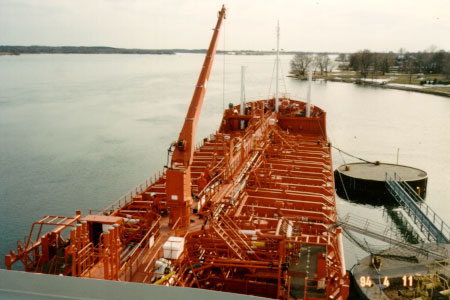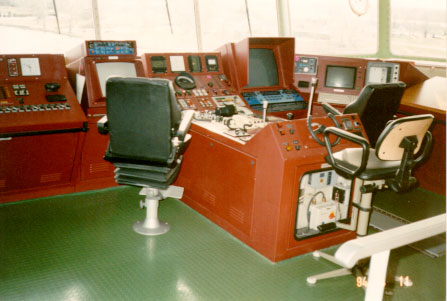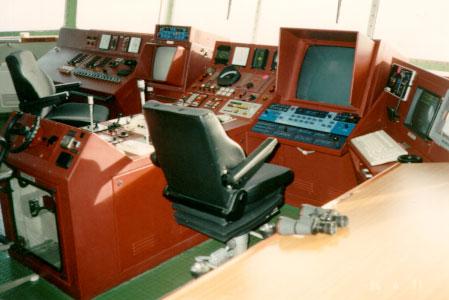Near-collision
of the Tanker "DIAMOND STAR" with a Pier of the Laviolette Bridge, Quebec
The Transportation Safety Board of Canada (TSB) investigated this occurrence for the purpose of advancing transportation safety. It is not the function of the Board to assign fault or determine civil or criminal liability. This report is not created for use in the context of legal, disciplinary or other proceedings. See Ownership and use of content. Masculine pronouns and position titles may be used to signify all genders to comply with the Canadian Transportation Accident Investigation and Safety Board Act (S.C. 1989, c. 3).
Summary
On 09 April 1994, the tanker "DIAMOND STAR" was en route from Saint-Romuald, Quebec, to Morrisburg, Ontario, with a full load of petroleum products. A few minutes after the pilot change at Trois-Rivières, Quebec, the ship's crew saw the north pier of the Laviolette bridge about 150 metres dead ahead of the vessel. An emergency manoeuvre was made and the collision was averted at the last moment.
The Board determined that the pilot's health and state of mind when he took the conduct of the "DIAMOND STAR" very likely led to the near-collision. Contributing factors to this occurrence were the adaptation of the eyes to darkness and the low brightness level of the navigation lights on the bridge.
1.0 Factual Information
1.1 Particulars of the Vessel
| DIAMOND STAR | |
|---|---|
| Official Number | 814363 |
| Port of Registry | Halifax, N.S. Footnote 1 |
| Flag | Canadian |
| Type | Liquid chemical carrier |
| Gross Tons Footnote 2 | 6,262 |
| Length | 118.16 m |
| Draught | F: 7.9 m A: 7.9 m |
| Complement | 15 |
| Built | 1992, Wismar, Germany |
| Propulsion | MAN B&W B6W engine capable of 3,700 kW at 210 rpm, driving a controllable-pitch propeller |
| Owners | Rigel Chem Elbe Limited, Isle of Man, United Kingdom |
1.1.1 Description of the Vessel
The "DIAMOND STAR" is a double-hulled tanker with the accommodation located aft. There is no superstructure obstructing the view from the wheel-house. The navigation bridge has a central integrated navigation console that the officer of the watch (OOW) can operate unassisted.
1.2 History of the Voyage
The "DIAMOND STAR" departed Saint-Romuald at 1612Footnote 3, 09 April 1994, bound for Morrisburg, with a cargo of 10,000 m³ of diesel oil. The voyage from Saint-Romuald to Trois-Rivières was uneventful. The pilot change, made about 1.5 miles downstream from the Laviolette bridge, was normal. Immediately after the pilot change, full-ahead power was resumed and the course was altered to follow the centre line of the channel under the Laviolette bridge.
The pilot took up a position at the workstation to the right of the central console. A few minutes later, at about 2220, the OOW and master saw the base of the north pier of the main span of the bridge close to, dead ahead of the vessel. The master ordered hard-a-port helm. The pilot then immediately ordered hard-a-starboard helm. The master repeated his order and the helm was turned hard-a-port. The vessel turned to port, missed the pier, and passed under the main span without touching the bridge substructure.
After the vessel cleared the bridge, the master noticed that the pilot smelled of alcohol. He ordered him to anchor the vessel for the night. The pilot was relieved from duty and, at approximately 0145 the next morning, another pilot was dispatched aboard the vessel.
At a special meeting of the members of the Laurentian Pilotage Authority (LPA) on 12 April 1994, it was resolved, in view of the report of the master of the "DIAMOND STAR" and the complaint filed by the vessel owners, Rigel Chem Elbe Ltd., to suspend the pilot's licence for 15 days beginning on 11 April 1994. It was further resolved to take measures to suspend the pilot's licence for an indefinite period. These measures were implemented.
1.3 Injuries to Persons
No one was injured as a result of the occurrence.
1.4 Damage
There was no damage to the vessel, and no environmental damage resulted from the occurrence.
1.5 Certification
1.5.1 Vessel
The vessel was certificated for the voyage being undertaken in accordance with existing regulations.
1.5.2 Personnel
The master held a Canadian certificate as Master, Foreign-going, issued on 25 January 1980.
The OOW held a Canadian Watchkeeping Mate's Certificate issued on 07 March 1990.
The pilot held a Canadian pilotage licence since 03 May 1972. He was issued a class A licence on 03 May 1977.
1.6 Personnel History
1.6.1 Master
The master had been sailing for about 30 years. He had nine years' experience as master. He also had nine years' experience on the St. Lawrence River. This was his second two-month tour of duty on the "DIAMOND STAR".
1.6.2 Officer of the Watch (OOW)
The OOW had been sailing for about 11 years, the last 3 as navigation officer. He had been on the "DIAMOND STAR" for about two months.
1.6.3 Pilot
The pilot had been sailing for 31 years. He had piloted in the No. 1 district of the LPA since 1972. This was his first assignment on this vessel.
On 08 April 1994, he was assigned to a vessel downbound on the St. Lawrence River. The passage took about five hours. He disembarked at Trois-Rivières around 1520 and stayed there until his next assignment. The pilot stated that he slept normally on the night of 08/09 April and from 1900 to 2000 that day before going aboard the "DIAMOND STAR".
1.7 Pilotage Act and Regulations
Section 25(3) of the Pilotage Act prohibits pilots from having the conduct of a ship when they know of any physical or mental disability that prevents them from performing their duties or when their ability is impaired by alcohol or a drug (see Appendix C).
According to the provisions of the Act, non-compliance may result in disciplinary measures up to and including cancellation of the pilot's pilotage licence.
1.8 Medical Information Concerning the Pilot
The investigation into the medical history of the pilot involved in the near-collision indicated that he had a severe alcohol addiction problem and related behavioural problems.
His problems with alcohol date back some 24 years. It was reported that his alcohol addiction sometimes affected his attitude and that his reactions were at times unusual. The diagnoses by the physicians who treated the pilot in recent years mentioned organic complaints caused by alcohol.
The pilot had been hospitalized in Montreal from 01 to 10 October 1992 to undergo treatment for his alcohol addiction.
On 29 June 1993, at his routine medical examination required by the LPA, the pilot stated that he had received treatment for alcohol addiction in 1992 and was currently totally abstaining.
On 22 July 1993, the pilot was admitted to an alcoholism treatment facility for detoxification and rehabilitation. He left the facility the same day.
On 11 March 1994, the pilot consulted a physician to tell him that he wanted to undergo treatment for alcohol addiction. He was admitted to an alcoholism treatment facility a month and a half later, that is, 17 days after the occurrence at the Laviolette bridge.
1.9 Medical Examinations for Pilots
The General Pilotage Regulations require that all licensed pilots and holders of a pilotage certificate undergo a medical examination at least once every three years. The physician appointed by the pilotage authority must send to the authority a written report of the examination results which clearly indicates if the person examined is medically fit or unfit to carry out pilotage duties.
The pilot of the "DIAMOND STAR" had the required medical examination on 29 June 1993. Responding to the questionnaire contained in the medical report, the pilot stated that, in 1992, he had received alcohol addiction treatment in a hospital and was currently totally abstaining. The LPA received this report which stated that the pilot was fit for duty ("apte à exercer les fonctions de pilote"). However, the LPA took no steps to follow up on the pilot's report and to check on his continued abstinence, nor to encourage him to continue with rehabilitation.
1.10 Assistance Program for Pilots
The investigation revealed that the acts and regulations relating to pilotage authorities and corporations in Canada do not provide for programs of prevention, diagnosis or assistance for pilots with drug or alcohol addiction problems.
The group insurance plan for the members and employees of the corporation, which covers the pilot of the "DIAMOND STAR", does not pay benefits to a pilot whose disability is caused by addiction to alcohol or drugs. However, if the insured receives medical care or treatment from a specialized organization or institution, benefits are provided, but will not continue during the rehabilitation period following treatment. Furthermore, the pilot cannot receive benefits if his licence has been suspended.
1.11 Proficiency Checks for Pilots
In order to be issued a pilotage licence for a given pilotage district, a ship's officer must receive at least two years' training followed by written and oral examinations. Successful candidates then receive a class C pilotage licence. After gaining the required experience, the pilot is issued a class B licence, and later a class A licence.
There is no regulatory requirement for holders of class C pilotage licences to upgrade their technical skills, and no further proficiency checks are administered.
1.12 Weather Information
At the time of the occurrence, the winds were light and visibility was good.
1.13 Ergonomics on the Bridge
The wheel-house is located above the main deck (see Appendix B) and visibility is good in all directions. The windows are large and separated by thin vertical frame members to minimize obstruction to visibility. There is a 360 field of view from inside the wheel-house. The forward windows are angled so as to reduce the glare which can sometimes affect visibility.
A T-shaped central integrated navigation console is located in the centre against the wheel-house forward bulkhead (see Appendix B). The workstation on the left side of the console has a radar screen and a number of switches and controls for vessel systems.
The workstation on the right side of the console has a 61 cm radar screen fitted with an Automatic Radar Plotting Aid (ARPA) system, controls for the main engine and bow thruster, and a terminal to operate the ship's computers and alarms. The helmsman's workstation completes the layout of the wheel-house and bridge.
1.14 Navigation Equipment
1.14.1 Vessel
The navigation instruments were in working order and no anomalies were reported.
1.14.2 Navigational Aids
At that time of the year (early spring), light buoys C65, C67 and C68 are not in place. However, the unlighted winter spar buoys were in their charted positions.
1.15 Laviolette Bridge
The Canadian Hydrographic Service publication, Sailing Directions, describes the Laviolette bridge as follows:
Pont Laviolette crosses the St. Lawrence River about 0.6 mile downstream of Pointe des Ormes. It has a vertical clearance of 50 m (164 ft) under the main span, 335 m (1 100 ft) in length. The bridge is well marked with lights. Two Racons are located on the Pont Laviolette; the north Racon () and the south Racon ().
Seen from downstream, the Laviolette bridge is marked by a series of seven lights mounted below the bridge span. These lights are red, green or white in colour. The green lights mark the mid-points of the main span and of the first two spans to the north. Two red lights indicate the maximum width of the centre channel, that is, 225 m. The roadway is illuminated by street lamps along the full length of the bridge.
The navigable width between the first two piers to the north of the channel is about 56 m, and minimum water depth is 11.8 m (see Appendix A).
1.16 Composition of the Bridge Watch
The bridge watch comprised the master, the third officer, a helmsman and the pilot.
2.0 Analysis
2.1 Introduction
The causes of the near-collision of the tanker "DIAMOND STAR" with a pier of the Laviolette bridge were analyzed in the light of the facts reported and the statements of the persons involved in the occurrence. The reports concerning the health of the pilot were obtained from the attending physicians and from health care facilities in accordance with the Canadian Transportation Accident Investigation and Safety Board Act.
2.2 Night Vision
When the pilot came aboard the vessel in the port of Trois-Rivières, he proceeded directly to the wheel-house via a lighted stairway. Only a few minutes elapsed between the pilot's taking the conduct of the vessel and the time the near-collision occurred. This period perhaps was not long enough to allow the pilot's eyes to adapt fully to the ambient light conditions.
2.3 Lighting on Screens and Indicators
Examination of the brightness of the radar screens and indicators in the wheel-house revealed that the lighting on these instruments can be adjusted to facilitate reading at all times. This lighting does not affect the vision of the bridge personnel, and exterior details can be seen normally after using the instruments. Examination of the area revealed no other light sources that could interfere with the work of the bridge personnel.
It is unlikely that the ergonomic characteristics of the bridge and bridge equipment, in particular the ARPA radar screen, contributed to the occurrence.
2.4 Bridge Resource Management (BRM)
When the pilot came aboard, he met briefly with the master, but little information was exchanged; it is not unusual for a vessel to change pilots in this manner. During their brief encounter, the master did not have enough time to detect anything unusual about the pilot's behaviour.
More effective BRM making better use of the resources available, such as equipment and communications, may have prompted the pilot to report that he could not locate the piers of the bridge and to ask the bridge personnel for assistance in locating them. He did not inform the ship's officers of his difficulties in identifying the channel, and the master had to intervene at the very last moment.
2.5 Laviolette Bridge
The Laviolette bridge is easily locatable at night because of the street lamps illuminating it. However, there have been several reports that the brightness level of the navigation lights marking the channel is low. Some persons apparently have difficulty determining the position of the bridge piers using these lights, even in conditions of good visibility.
Since the bridge piers have been protected by rock berms, it is risky for a vessel the size of the "DIAMOND STAR" to pass under the Laviolette bridge between the first two piers to the north of the centre channel. The pilot stated that, at the last minute, he had decided to steer through that channel. Given the critical situation, this was not without hazards. The risk of accident was even greater because the master was not aware of the pilot's intention and the situation was unclear.
2.6 Pilot's Health
The master of the "DIAMOND STAR" maintained that the pilot's reactions were not normal, that he was either under the influence of alcohol or drugs, or incompetent. Because the pilot did not undergo tests to determine if his ability was actually impaired by drugs or alcohol at the time of the occurrence, this question cannot be resolved.
The pilot's medical history indicated that he had been suffering from chronic alcoholism for many years. He had signed up a few times for alcoholism treatment programs offered by health care facilities.
It is well known that alcohol abuse over a prolonged period can have long-term effects on a person. These effects can cause functional disorders, whether physical or mental, that sometimes affect an individual's performance.Footnote 4
2.7 Assistance Program for Pilots
Because the acts and regulations governing pilots do not make provisions to assist pilots who need professional treatment for alcohol or drug abuse, pilots have only two options:
- undergoing treatment during off-duty periods without informing the pilotage authority or corporation to avoid risking suspension of their licence; or
- requesting assistance from the pilotage authority or corporation without knowing whether they will be helped or have their licence suspended.
Both options involve financial and personal risks for the pilot and offer no incentive to participate in a rehabilitation program.
3.0 Findings
- At the time of the occurrence, the pilot had been on board the "DIAMOND STAR" for only a few minutes.
- The unlighted spar buoys marking the channel at the Laviolette bridge were in their charted positions and the racons marking the north and south sides were working properly.
- It has been reported that the brightness level of the navigation lights located under the bridge span is low.
- Little information was exchanged between the pilot and crew. The pilot did not ask the bridge personnel for assistance in locating the bridge piers.
- The pilot had a severe alcohol addiction problem.
- There was no program for the prevention and diagnosis of alcohol and/or drug addiction for marine pilots.
- Pilots are required to have a medical examination at least once every three years.
- The Laurentian Pilotage Authority (LPA) took no steps to follow up on the pilot's report and to check on his continued abstinence, nor to encourage him to continue with rehabilitation.
- The ergonomic characteristics of the bridge apparently did not contribute to the occurrence.
3.1 Causes and contributing factors
The pilot's health and state of mind when he took the conduct of the "DIAMOND STAR" very likely led to the near-collision. Contributing factors to this occurrence were the adaptation of the eyes to darkness and the low brightness level of the navigation lights on the bridge.<
4.0 Safety Action
4.1 Safety Action Taken
4.1.1 Audit of Medical Reports
Following this occurrence, the pilot, whose licence was suspended for four months, underwent detoxification treatment. Thereafter, the Laurentian Pilotage Authority (LPA) proceeded to test the pilot at random for drug and alcohol use. The pilot agreed to these tests which were a condition to the suspension of his licence being lifted.
In the weeks following this occurrence, the pilotage authority contacted appointed medical doctors to make them aware of the importance of submitting medical reports written legibly and in layman's terms. The pilotage authority also changed its internal procedure for auditing medical reports in order to detect any potential problem.
4.1.2 Medical Fitness for Duty
In its report on the collision between the Canadian Coast Guard Ship "GRIFFON" and the fishing vessel "CAPTAIN K" which occurred in Long Point Bay, Lake Erie, on 18 March 1991 (TSB Report No. M91C2004), the Board recommended that:
The Department of Transport, in cooperation with Health Canada and the Canadian Coast Guard, define policies and procedures to ensure that personnel returning to safety-sensitive duties following any medical treatment are fit for those duties.
Transportation Safety Recommendation M95-05 (Issued July 1995)
In response to this recommendation, Transport Canada, Health Canada and the Canadian Coast Guard held meetings with groups of employers and employees of the commercial shipping industry. The consensus which came out of these meetings was that the anticipated results will be achieved through the recently modified Crewing Regulations. If there is any doubt as to an employee's physical and/or mental fitness for duty, Transport Canada and the shipowners will have the authority to require that employee to undergo another medical exam before returning to work.
4.1.3 Lighting of the Laviolette Bridge Piers
Following this occurrence and at the request of ship's pilots, Transports Québec has fitted additional lights under the bridge to illuminate the first two piers on each side of the centre channel.
This report concludes the Transportation Safety Board's investigation into this occurrence. Consequently, the Board, consisting of Chairperson, John W. Stants, and members Zita Brunet and Maurice Harquail, authorized the release of this report on .
Appendices
Appendix A - Sketch of the Occurrence Area
Appendix B - Photographs
Appendix C - Section 25 of the Pilotage Act
- 25. (1) Except as provided in the regulations, no person shall have the conduct of a ship within a compulsory pilotage area unless the person is a licensed pilot or a regular member of the complement of the ship who is the holder of a pilotage certificate for that area.
Pilot responsible to master
- (2) A licensed pilot who has the conduct of a ship is responsible to the master for the safe navigation of the ship.
When disqualified from pilotage
- (3) No licensed pilot or holder of a pilotage certificate
- who knows of any physical or mental disability that prevents that pilot or holder from meeting the qualifications required of a holder of a licence or pilotage certificate,
- whose ability is impaired by alcohol or a drug or from any other cause, or
- whose licence or pilotage certificate is suspended,
- shall have the conduct of a ship within a compulsory pilotage area or be on duty on board ship pursuant to a regulation of an Authority requiring a ship to have a licensed pilot or holder of a pilotage certificate on board.
Prohibition of alcohol or drug consumption
- (4) No licensed pilot or holder of a pilotage certificate shall, while on duty, consume alcohol or any drug that may impair the ability of that pilot or holder to have the conduct of the ship.
Appendix D - Glossary
- A
- aft
- ARPA
- Automatic Radar Plotting Aid
- BRM
- Bridge Resource Management
- cm
- centimetre(s)
- EDT
- eastern daylight time
- F
- forward
- IMO
- International Maritime Organization
- kW
- kilowatt(s)
- LPA
- Laurentian Pilotage Authority
- m
- metre(s)
- m3
- cubic metre(s)
- N.S.
- Nova Scotia
- OOW
- officer of the watch
- rpm
- revolution(s) per minute
- SI
- International System (of units)
- TSB
- Transportation Safety Board of Canada
- UTC
- Coordinated Universal Time
- °
- degree(s)
